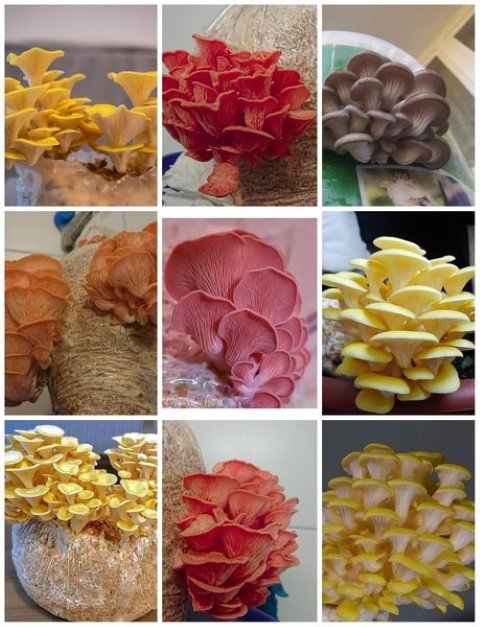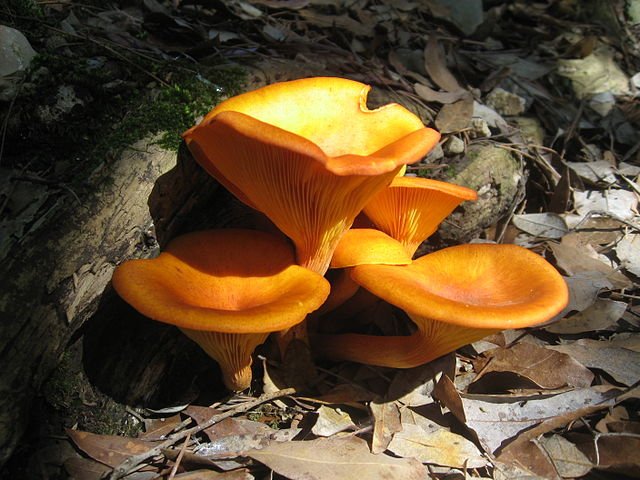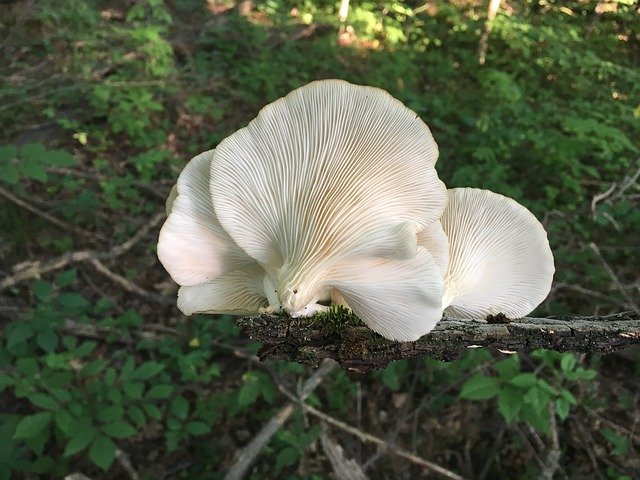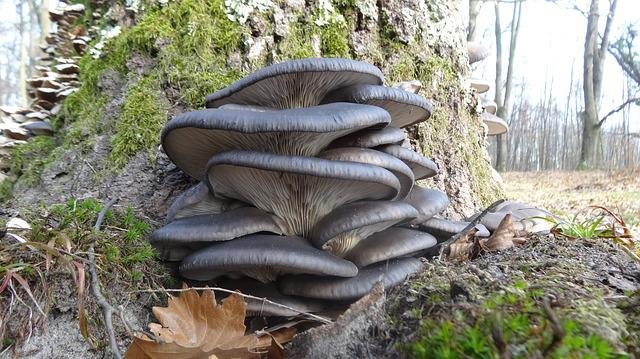Oyster mushrooms are beloved worldwide by cultivators and foragers alike due to their ease of identification, hearty growing ability, and unique and delectable flavor.
Hunting for oyster mushrooms is a relaxing and enjoyable outdoor activity for all ages and abilities. With a little bit of knowledge of how to identify oyster mushrooms, where to find them, and lookalikes to be aware of, you can harvest your own wild oyster mushrooms to enjoy for a delicious meal.
Sure, you can grow your own oyster mushrooms and we have several articles about how to grow them but hunting for wild oyster mushrooms is a unique experience. There’s nothing like finding and harvesting a few handfuls of oyster mushrooms while enjoying a beautiful hike through the forest.
What Are Oyster Mushrooms?
Oyster mushrooms or Pleurotus ostreatus, are a species of edible gourmet mushrooms found in the wild all over the world. Oyster mushrooms are also commonly cultivated by commercial operations, small farms, and hobby growers.
With fanned oyster-shaped caps that grow in a shelf-like manner, oyster mushrooms are an unmistakable and a go-to favorite for mushroom lovers that are a great addition to just about any dish.
Due to their hearty growing habits, oyster mushrooms can be found in a variety of habitats and conditions. Chances are you’ll be able to find a few wild oyster mushrooms close to your home.
Oyster Mushroom Identification
With an unmistakable look that makes them easy to identify even for the inexperienced, oyster mushrooms are a great place to start for beginner mushroom hunters because there are only a few lookalikes.

Oyster mushrooms have a cupped, ear-like shape much like an oyster, which is unsurprisingly where they get their name. Oyster mushrooms appear in a variety of colors such as whites, cream colors, browns, greys, bluish, reddish, pinks, and yellows.
Shape and color are easy ways to identify oyster mushrooms, but they can also be identified by their white-colored gills. The only distinct pattern for gills on oyster mushrooms is they typically run all the way down to the stem. Gills on oyster mushrooms are also somewhat more spread out and not close together in most cases. This gill pattern is not the case for oyster mushroom lookalikes where their gills don’t usually run all the way down the stem.

Smelling oyster mushrooms to identify them is also a good tactic. Many experts say the distinct smell of oyster mushrooms is reminiscent of anise or black licorice. Yellow oyster mushrooms on the other hand are said to have a citrus-like aroma. If the mushroom you’re trying to identify doesn’t have this distinct smell, it’s probably not an oyster mushroom or at the very least it’s not fresh.
Where oyster mushrooms grow is quite predictable as well, so you’ll be able to determine if you’re looking at an oyster mushroom or not by what kind of substrate you find it on. In addition, the tendency for oyster mushrooms to grow in clusters is another way to identify them. Oyster mushrooms will rarely grow individually, so if you find a single mushroom, it may not be an oyster mushroom.
Poisonous Lookalikes
Oyster mushrooms have a few poisonous lookalikes, but as long as you know what to look for and confirm with your mushroom guide books, it’s easy to tell what is and what isn’t an oyster mushroom.
We’ve published another article on oyster mushroom lookalikes in more detail that you can find here
https://oyster-mushroom.com/oyster-mushroom-identification-and-poisonous-lookalikes/
Poisonous lookalikes include Jack O Lantern mushrooms, which closely resemble oyster mushrooms in shape, but their bright orange color is not present in any oyster mushroom variety. Elm oyster mushrooms though not a true oyster mushroom, bear a similar appearance to actual oyster mushrooms. Elm oyster mushrooms are not poisonous, but their flavor is not as well regarded.

Ghost fungus and Funnel mushrooms are also known as poisonous lookalikes, but the ghost fungus’s bioluminescence is a dead giveaway as is the gill structure of the funnel mushroom that stops at the base of the stem.

When foraging for any wild mushroom, don’t eat anything until you’re certain you know what species it is and that it’s edible for humans. Some species of wild mushrooms can make you very sick at least, while some are potentially deadly.
If you’re not sure if what you harvest is an oyster mushroom or not, check with images and guidebooks to be sure. You can also consult with mushroom experts or people you know who are knowledgeable about mushroom identification. If you’re still unsure, don’t take any chances, and don’t consume the mushroom.
Where to Look for Oyster Mushroom
Oyster mushrooms are very predictable when it comes to where to find them in the wild. Knowing a few fundamentals about where to find oyster mushrooms will allow you to find them time and time again with little effort.
Known to be saprophytic, meaning they grow on dead or dying plant matter, oyster mushrooms need cellulose to grow, so you’ll most commonly find them growing on dead or dying trees.

When hunting for oyster mushrooms, a good strategy is to look for dead or dying trees in a forested area instead of looking for the mushrooms themselves. Looking for dead and dying trees will consequently bring you right to the mushrooms.

Dead or dying hardwood trees, more specifically deciduous trees, are where oyster mushrooms most commonly grow. Deciduous trees are trees that lose their leaves leading up to winter and their wood is denser compared to coniferous or pine trees. Common hardwood species you’ll likely see oyster mushrooms growing on include oak, aspen, maple, and many others.
On these dead or dying hardwood trees, oyster mushrooms will always grow in clusters. It’s extremely rare to find a single oyster mushroom, so when you find them, you’ll find a bunch of them clustered together. This makes oyster mushrooms a worthwhile foraging species because when you find oyster mushrooms, you’ll most likely get a sizeable harvest that makes all the miles trekked well worth it.
Seasons and Weather Conditions for Hunting Oyster Mushroom
While many wild mushrooms are seasonal and require very specific conditions to flush, oyster mushrooms will grow almost year-round in a variety of conditions and temperatures.
Oyster mushrooms are found all over the world from tropical rainforests to more temperate climates. With the many varieties of oyster mushrooms, you can forage throughout the year, especially for black varieties such as the blue oyster mushrooms that tend to grow in colder climates.
Although oyster mushroom hunting can be an almost year-round activity, the most productive seasons for foraging are early spring through late fall. Oyster mushrooms will have enough warmth and moisture during this time to grow multiple flushes.
Similar to hunting for other types of mushrooms, hunting for oyster mushrooms is best after a soaking rain, especially if you wait a day or so after. The moisture allows the mushrooms to flush through the substrate and fruit to full maturity, allowing you to harvest them for your next meal.
The next time it rains in your area, give oyster mushroom hunting a try at your nearest wooded park or forested area and look for dead and dying trees. Before you know it, you’ll have a bag full of oyster mushrooms ready to enjoy.
Harvesting Oyster Mushroom
Harvesting oyster mushrooms is a no-brainer, but there are a few things you’ll need to look out for to make sure you’re harvesting them at the peak of freshness. The first step to harvesting table-worthy oyster mushrooms is to examine them to see if they’re worth taking home or past their prime.
Perfectly fresh oyster mushrooms will be firm and smooth with little to no holes from burrowing insects. If the edges of the mushrooms are frayed and cracked, or there are splits in the caps, odds are the mushrooms are past their prime and it’s best to just leave them where they are. Once you’ve identified fresh mushrooms, it’s time to harvest.
Use a serrated or sharp knife to cut the mushrooms at the stem. Once you have collected your mushrooms, place them in a mesh bag or other breathable material. Using a plastic bag will cause the mushrooms “sweat” and make them lose their freshness. Oyster mushrooms don’t have a very long shelf life, so make sure to cook and enjoy harvested mushrooms as soon as possible.
Fresh oyster mushrooms pair well with grilled meats or vegetables and are a great addition to sauces, soups, and stews.
Conclusion
Oyster mushroom hunting is a fun activity, and with the right know-how, you can harvest delicious wild oyster mushrooms throughout the year.
Mushroom hunting gives you the ability to search for mushrooms that are difficult to find in supermarkets, so foraging for them is the best way to experience their characteristics and flavor. Searching for mushrooms in their native environment is an awe-inspiring experience all mushroom enthusiasts should experience.
As long as you remember to look for dead or dying hardwood trees, go after a soaking rain, and make sure you inspect mushrooms for freshness, oyster mushroom hunting is an easy-going activity that will soon become your favorite pastime.




